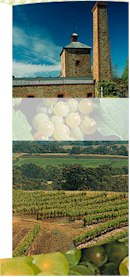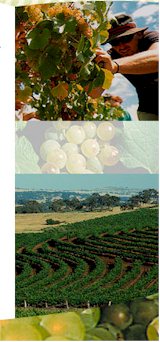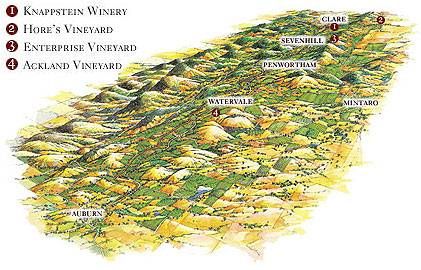


Knappstein are a small producer of premium quality wines, who manage their own vineyards. Redeveloped around the historic Enterprise Brewery building at the heart of Clare township, and deeply connected to the community and cultural life of Clare. The Knappstein name has been involved in the wine business in Clare since 1895. The winery was originally founded by Tim Knappstein as Enterprise Wines, a name utilised for the premium Cabernet Sauvignon vineyard and thus honouring the Knappstein heritage as early winemakers connected with Clare for well over 100 years.

The Clare Valley lies 130km north of Adelaide and 60km east of the Gulf St. Vincent perched high amid the North Mount Lofty Ranges. As one of Australia's longest established regions, with plantings by the Jesuits dating back to 1851, the Clare Valley is also one of the most defined regions in terms of climate, geology, soils, varieties, viticultural techniques and quality of wine.
The north / south oriented Clare Valley is approximately 40km long and 14km wide with the bottom of the valley lying at about 250 metres above sea level and its eastern escarpment rising to over 580 metres. As a result significant differences exist between vineyards in their altitude, latitude and individual topography. The latter is reflected in many mesmerising contour vineyards which most clearly depict this unique region.
Over the past 20 years the Knappstein winemakers have developed an almost intuitive understanding of the Clare Valley. Central to the understanding of the affinity certain grape varieties have with the region, are the efforts over the past 10 years to ensure a natural environment under which the vines can find their innate balance. Hand pruning of all the vines, and hand picking of the delicate varieties have been obvious choices for the winemakers. A more subtle environmental choice has been the planting of permanent rye grass between rows. This has not only eliminated unnecessary compaction of the ground by plough machinery and prevented the erosion of the unique mosaic of soils, but also caused distinct changes in the meso-climate.

The winery's decision to un-graft some Chardonnay in preference of its 30 year old Shiraz rootstock was an unfashionable choice in the 1990s. By allowing the vines to find their natural balance, Knappstein has best been able to understand the quality and characteristics of the different sites. Of these, three 30 year old vineyards have excelled with unique characteristics and calibre for their respective variety.
In 1971, Knappstein's Ackland Vineyard was planted at the cool altitudes of 420-450 metres overlooking nearby Watervale township. Its east and north-east facing aspect protects the vines from the prevailing winds off the Great Southern Ocean. Thus whilst capturing the full morning sun to develop strong lime and citrus flavours the high natural acids are greatly enhanced by the cold night-time temperatures of this altitude. The slate and shaley rock abundant in the Ackland vineyard soils play a crucial role in the aromatic development of the Riesling, whilst the delicate floral nuances are unique to the handful of vineyards within this Watervale area. Further north on a slightly warmer site, located on the Clare Valley's famous Terra Rosa soils over limestone, is Knappstein's Enterprise Vineyard. The low-yielding Cabernet vines of this vineyard bear fruit with incredibly bold concentration of flavour, distinctive mint-eucalypt flavours with fine natural tannins and striking acidity derived from the iron rich soils and the limestone geology. Planted in 1969, the calibre and typicity of the vineyard has shone through consistently over time, and now is the source of the Knappstein Single Vineyard Cabernet Sauvignon. This vineyard has produced all the Enterprise Cabernet Sauvignon since 1974.
"Knappstein Lenswood Vineyards is now the sole (and full-time) occupation of Tim and Annie Knappstein, Tim Knappstein having retired from the winery which bears his name in the Clare Valley, and having sold most of the Clare vineyards to Petaluma (along with the wine business). With 25.5 hectares of close-planted, vertically trained vineyards maintained to the exacting standards of Tim Knappstein, the business will undoubtedly add to the reputation of the Adelaide Hills as an ultra-premium area!" -James Halliday
